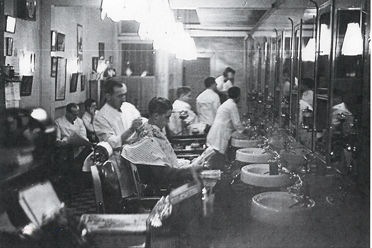Princeton History in Black and White in Historical Society’s New Exhibit


BYGONE BARBERS: This shot of the interior of Jack Honore’s Barbershop, which opened on Nassau Street around 1913, is among the 90 bringing the town’s past to life in the show currently on view at the Historical Society of Princeton’s two locations. (Photo courtesy of Historical Society of Princeton)
Most towns the size of Princeton have collections of historical photographs that offer clear clues to the past. But few can claim treasure troves as extensive as that of the Historical Society of Princeton. Thanks to the town’s bygone and long-active Rose Photography Studio, as well as others adept with a camera, everyday life in 19th and early 20th century Princeton is especially well documented.
An exhibit currently on view in the Historical Society’s two locations, at Bainbridge House at 158 Nassau Street and Updike Farm on Quaker Road, shows an exceptional range. Many of the images in “Princeton’s Portrait: Vintage Photographs from the Historical Society of Princeton” have never been previously exhibited. The show divides 90 shots between the two locations.
During a break in the installation process last week, guest curator Ellen M. Snyder-Grenier, who has developed past exhibitions at the Historical Society, reflected on its archives. “The breadth and diversity of the collection here is remarkable,” she said. “It’s especially strong for the late 1800s and early 1900s. I also appreciate it for its very rich collection reflecting the long-standing African-American community in Princeton. That, I think, is truly unusual.”
In a 1920 photo, Philip Diggs, Princeton Borough’s first African-American police officer, poses proudly in his uniform. Images run the gamut, showing many aspects of life in town and in rural settings. There is the interior of Hulit’s shoe store in the 1930s, a bit different from the way it looks today. A group of employees stand in front of 120 Nassau Street, known then as Leggett’s City Market; another worker can be seen looking out of the window from within.
The show is divided into different categories, showing Princeton residents at home, at play, and at work. Dated 1911 is an exterior shot of the Central Hotel, which was later home to Lahiere’s restaurant and today houses the popular eatery Agricola. J. D. Lawrence’s ambulance, which doubled as a hearse, is shown in a 1923 photo. A group of salesmen inside Farr’s Hardware at Nassau and Mercer Street is dated 1900.
Among the photos depicting lighter moments is one from 1897 showing the Jared Wolfe family, clowning around with musical instruments on their porch at 19 Vandeventer Street. Another shot shows a potato sack race in Rocky Hill from 1908. In an image from around 1910, Princeton University students are dressed up for the St. Patrick’s Day Parade. A sign held by one student reads, “They furnish the beans, I spill the hot air.”
Princeton’s Rose Studio, which documented life in town and on the campus from the early 1870s to 1951, is the source for many, but not all, of the images in the show. “It was very hard to choose what to use,” said Daniel Schnur, the exhibition’s designer. “So we had our intern put them on a DVD that will run and show all the ones we couldn’t use.”
That intern, Princeton native and recent Princeton University graduate Isabel Kasdin, was struck by what she found when combing through the collection. “It was a true joy looking through every plate and print within our tens of thousands of photographs,” she wrote in an email. “I was struck with awe as I flipped over each new treasure. There were some wonderful surprises along the way, such as discovering an 1850s daguerrotype from the studio of Mathew Brady, one of the most famous early American photographers. I feel so lucky to have access to so extensive a visual representation of the history of the town in which I grew up.”
Prints from the show are available for purchase, with proceeds going to help support the Historical Society. The organization will move all of its operations to Updike Farm in 2016. Bainbridge House is owned by Princeton University, which has yet to announce its plans for the building.
Admission to the show is $4. On Nassau Street, hours are Wednesday-Sunday from noon to 4 p.m. The exhibit is on view at Updike Farm from 12-4 p.m. the first Saturday of every month. Visit www.princetonhistory.org for more information.

